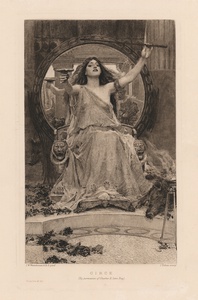| Method | Etching |
| Artist | James Dobie after John William Waterhouse |
| Published | Magazine of Art. [c. 1892] |
| Dimensions | Image 225 x 140 mm, Plate 255 x 155 mm, Sheet 302 x 225 mm |
| Notes |
A scene depicting Circe proffering the potion to Odysseus published in The Magazine of Art. The Magazine of Art was an illustrated monthly British journal devoted to the visual arts, published from May 1878 to July 1904 in London and New York by Cassell, Petter, Galpin & Co. It included reviews of exhibitions, articles about artists and all branches of the visual arts, as well as some poetry, and was lavishly illustrated by leading engravers of the period. Circe is a mythological figure who features in Homer's Odyssey. According to the epic poem, she resides over the island of Aeaea, and turns six members of Odysseus' crew into pigs after offering them wine. In Waterhouse's work, Circe proffers the potion to Odysseus, though he has been warned of her treachery by Eurylochus, and the Olympian, Hermes. She holds a goblet in her right hand, and a wand in her left, which she raises above her head. Odysseus' reflection appears behind her. The circular mirror, like the femme fatale, was a theme often employed by the Pre-Raphaelites. It was used in Holman Hunt's 'Lady of Shallot,' 1850, as well as Ford Madox Brown's 'Take Your Son, Sir,' 1851, and is believed to have derived from Jan Van Eyck's 'Arnolfini Portrait,' 1434. In addition to the image of Odysseus, the penteconter with which they reached the island appears in reflection, as do the pigs: one the bottom left, another skulks behind Circe's thrown, whilst a third lies on the floor. James Dobie (1849 - 1911) was a British engraver who was born in Edinburgh, but worked on the periphery of London for a large part of his career. He was on the most part an etcher of landscape and genre scenes, and exhibited these works at the Royal Academy from 1885, until his death in 1911. He would often, but not exclusively, sign his engravings with 'J.D.' John William Waterhouse (1849 - 1917) was an historical genre painter whose revivalist manner earned him the sobriquet of 'the modern Pre-Raphaelite.' Waterhouse was born of English parents in Rome. He studied under his father, who was a painter and copyist, before enrolling in the Royal Academy schools in 1870. He exhibited at the Society of British Artists from 1872, and at the Royal Academy itself, from 1874. Waterhouse was the most celebrated of the artists who, from the 1880's, sought to reinvigorate the literary themes popularised by the Pre-Raphaelite Brotherhood. In 1895, Waterhouse was elected to the status of full Academician. Though very much a Pre-Raphaelite in his choice of Greco-Roman and Arthurian subject matter, Waterhouse did deviate from the Brotherhood's technical approach to painting. Whilst his rendering of certain details was fastidious, his fondness for backgrounds conceived as blocks of colour and tone went against Pre-Raphaelite doctrine. These ultimately derived from the methods of European prototypes such as Jules Bastien-Lepage, which were transmitted to Waterhouse through his acquaintance with members of the Newlyn school. In the twilight of his career, Waterhouse taught at the St. John's Wood Art School, and served on the Royal Academy Council. |
| Framing | mounted |
| Price | £250.00 |
| Stock ID | 52197 |

